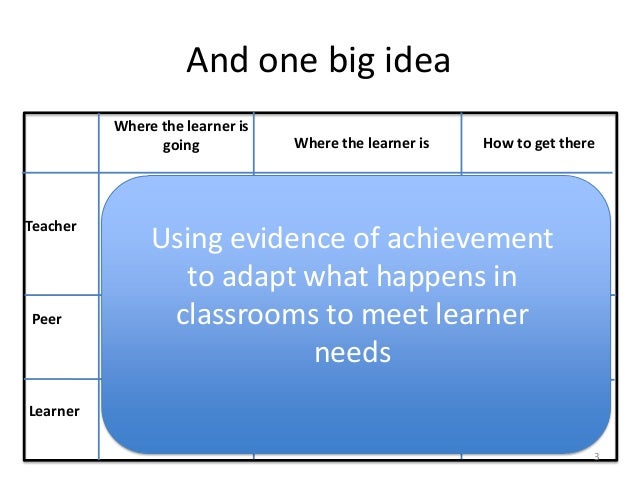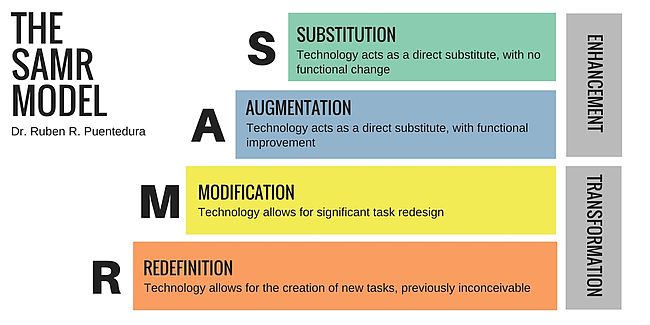Blended Learning and Formative Assessment: What are they and why are we looking at them together?
The inquiry question which we are seeking to answer in our Hardie Fellowship is this: How can best practice in blended learning and formative assessment, enhance online
and classroom learning experiences for Tasmanian students and teachers and by doing so increase
retention and attainment?
In this post I'll focus on what blended learning and formative assessment are and why we are considering them together. Future posts will include why we are considering them at all and how we will be investigating them during our Hardie Fellowship!
What is Blended Learning?
In essence it is the integration, to a greater or lesser degree, of online or digital learning with traditional face-to-face learning.
There are many models - and no fully agreed upon definition - but one way to think about blended learning is the degree to which learners are engaging in face-to-face or online learning combined with the degree to which their learning is in a synchronous (lock-stepped) or asynchronous (self-paced) delivery model. Some common variations of blended learning are described on the diagram below.
In this post I'll focus on what blended learning and formative assessment are and why we are considering them together. Future posts will include why we are considering them at all and how we will be investigating them during our Hardie Fellowship!
What is Blended Learning?
In essence it is the integration, to a greater or lesser degree, of online or digital learning with traditional face-to-face learning.
There are many models - and no fully agreed upon definition - but one way to think about blended learning is the degree to which learners are engaging in face-to-face or online learning combined with the degree to which their learning is in a synchronous (lock-stepped) or asynchronous (self-paced) delivery model. Some common variations of blended learning are described on the diagram below.
For instance - the top left area of the diagram represents traditional classroom practice; students coming to a physical classroom, working through a set learning sequence at the pace of 'one course per calendar year' with learners moving roughly at the pace of the class in order to cover all the material by the end of the year.
The bottom right section describes its opposite - a totally online self-paced course where learners work in a digital environment, completing work as and when they choose.
Various fully online learning models can be found in the lower third of the diagram.
Many MOOCs (Massive Open Online Courses) would fit in the bottom-middle section - entirely online, but taking place within fixed start and end points with various points at which learners must interact with others but able to complete much of the learning at their own pace and in their own time.
This, together with the middle third of the diagram is the space in which many concepts of 'classroom' blended learning lie with learners operating partly in an online space and partly in a face-to-face setting, perhaps utilising concepts such as 'flipping' the classroom ("if you can be replaced by a video - you probably should be!") or perhaps simply augmenting existing classroom practice with technology. Some elements may be self-paced, others may be in lock-step with other learners - or somewhere in-between. And this only covers some of the possible models - there are many!
What is Formative Assessment?
The second focus is formative assessment (or assessment for learning). There are various definitions from different researchers (Broadfoot et al. 2002, Stiggins 2005, Popham 2008), but the one that has always resonated most strongly with me is the Leahy et al. (2005) concept of Formative Assessment as 5 Key Strategies underpinned by One Big Idea.
The 5 Key strategies involve three agents (learner, peer, teacher) in three processes; where is the learner now, where are they going and how will they get there.Various fully online learning models can be found in the lower third of the diagram.
Many MOOCs (Massive Open Online Courses) would fit in the bottom-middle section - entirely online, but taking place within fixed start and end points with various points at which learners must interact with others but able to complete much of the learning at their own pace and in their own time.
This, together with the middle third of the diagram is the space in which many concepts of 'classroom' blended learning lie with learners operating partly in an online space and partly in a face-to-face setting, perhaps utilising concepts such as 'flipping' the classroom ("if you can be replaced by a video - you probably should be!") or perhaps simply augmenting existing classroom practice with technology. Some elements may be self-paced, others may be in lock-step with other learners - or somewhere in-between. And this only covers some of the possible models - there are many!
What is Formative Assessment?
The second focus is formative assessment (or assessment for learning). There are various definitions from different researchers (Broadfoot et al. 2002, Stiggins 2005, Popham 2008), but the one that has always resonated most strongly with me is the Leahy et al. (2005) concept of Formative Assessment as 5 Key Strategies underpinned by One Big Idea.
| Leahy, Lyon, Thompson, Wiliam (2005) |
Considered this way formative assessment is not a 'thing'. As Wiliam states, it is not '"any assessment before the big one"'. It should not be thought of in terms of 'this one is a formative assessment' and 'this one is a summative assessment'.
It is, rather, an ongoing and continuous process of doing - of providing feedback that moves learning forward and engaging all agents; learner, peers and teacher, in the process. It is a process of generating and sharing clear understanding for all agents about where the learner is going (explicit learning intentions) and how they will know when they have got there (explicit success criteria). It is the process by which information is elicited which can then be used to adapt how and what is taught. It is the activating of learners 'as resources for one another' and as 'owners of their own learning.' And it is underpinned by One Big Idea; that assessment is formative to the extent that the information it provides is used to adapt teaching and learning to meet learner needs. And as Wiliam notes - this is at its most powerful when it is minute by minute rather than over longer cycles.
 |
| Wiliam - One Big Idea of Formative Assessment |
Why look at blended learning and formative assessment together?
As we consider the impact of blended learning - then the word 'classrooms' in the 'One Big Idea' statement above becomes variable; the classroom may be physical, digital or both, but the principle of using evidence of achievement to adapt learning experiences to meet learner needs, does not change.
So, as we move into increasingly blended environments - the challenge is to not just replicate good and effective classroom practices of formative assessment but to enhance and improve practices of formative assessment utilising the technology available. It is important that we do not simply Substitute or Augment existing practice and resources (as in Rueben Puentedura's SAMR model of integration of technology) but we must Modify and Redefine what can be done with the technology and do so in ways that we may not yet have conceived!
 |
| SAMR Model of use of technology |
Blended learning and formative assessment also come together in the concept of adaptive learning and adaptive testing; for more on this see ACER CEO Geoff Masters on the present and future of online assessment.
What we are investigating is blended learning and formative assessment, and why both of them is because the two are, in the sense outlined above, inextricably linked; we can't talk about improving blended learning without improving assessment, and we can't talk about improving assessment without talking about formative assessment.
So, there's the what - more on the why and the how in future posts!
Mark

Nice Summary Mark. I did some work on this a couple of years back. As you know Don College has made AfL a focus, but working in a computer lab I struggled to apply Wiliam's techniques directly. I did some adaptation for the online environment.
ReplyDeletehttps://doncollegegrant.wordpress.com/2015/04/21/assessment-for-learning-in-an-online-environment/
This looks a bit clumsy to me now, and it is more in the line of augmentation than modification.
I am thinking that incorporating new ideas such as participatory pedagogy and gamefulness might show the way forward.
Thinking of blended learning, I don't know if this term is very useful any more. Now that most kids have a device of some sort in their classroom every lesson is blended in some way (either for better or worse). The key is the pedagogy used to leverage the blended environment. My thinking is that we need to start to use terms that are descriptive of the pedagogy rather than the learning environment.
Thanks Grant - agree blended can be a very broad term - and you're right - with the ubiquity of smartphones if nothing else, every classroom is (or potentially is?) blended to some extent. And I think you're absolutely right that it's the pedagogy used to leverage technology that's important - hoping to learn lots more about how to do that in the coming weeks!
ReplyDelete